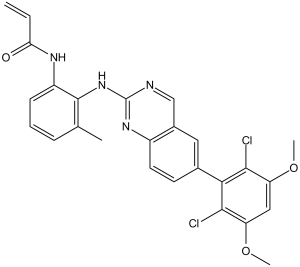BLU9931
This product is for research use only, not for human use. We do not sell to patients.

For small sizes, please check our retail website as below: www.invivochem.com
| Size | Price | Stock |
|---|---|---|
| 250mg | $860 | In Stock |
| 500mg | $1450 | In Stock |
| 1g | $2175 | In Stock |
Cat #: V0617 CAS #: 1538604-68-0 Purity ≥ 98%
Description: BLU9931 (BLU-9931; BLU 9931) is an irreversible and selective FGFR4 inhibitor with potential anticancer activity.
Top Publications Citing Invivochem Products
Publications Citing InvivoChem Products
Product Promise

- Physicochemical and Storage Information
- Protocol
- Related Biological Data
- Stock Solution Preparation
- Quality Control Documentation
| Molecular Weight (MW) | 509.38 |
|---|---|
| Molecular Formula | C26H22Cl2N4O3 |
| CAS No. | 1538604-68-0 |
| Storage | -20℃ for 3 years in powder formr |
| -80℃ for 2 years in solvent | |
| Solubility In Vitro | DMSO: 4 mg/mL (7.9 mM)r |
| Water: <1 mg/mLr | |
| Ethanol:<1 mg/mL | |
| Solubility In Vivo | 0.5% carboxymethylcellulose+1% Tween 80 as a suspension: 30mg/mL |
| SMILES Code | C=CC(NC1=CC=CC(C)=C1NC2=NC=C3C=C(C4=C(Cl)C(OC)=CC(OC)=C4Cl)C=CC3=N2)=O |
| Synonyms | BLU9931; BLU 9931; BLU-9931; |
| Protocol | In Vitro | BLU9931 (100 nM; 0 -24 hours; Hep 3B cells) treatment increases CYP7A1 mRNA expression and the expression of the proliferative marker EGR1 is inhibited. BLU9931 shows dose-dependent inhibition of the signaling cascade downstream of FGFR4. BLU9931 exhibits potent inhibition of phosphorylation of the FGFR4 pathway components in Hep 3B cells. BLU9931 treatment leads to induction of caspase-3/7 activity, indicative of induction of apoptosis that results in inhibition of signaling downstream of FGFR4. BLU9931 (0.3-300 nM; 1 hour; MDA-MB-453 and Hep 3B cells) treatment demonstrates potent, dose-dependent reduction of phosphorylation of FGFR4 signaling pathway components, including fibroblast growth factor receptor substrate 2 (FRS2), MAPK, and AKT in MDA-MB-453 cells. BLU9931 inhibits proliferation of HCC cell lines that express an intact FGFR4 signaling complex, with EC50s of 0.07 μM, 0.11 μM and 0.02 μM for Hep 3B, HuH7 and JHH7 cells, respectively. |
|---|---|---|
| In Vivo | BLU9931 (10-100 mg/kg; oral administration; twice every day; for 21 days; mice) treatment demonstrates antitumor activity in HCC xenograft models. |
These protocols are for reference only. InvivoChem does not
independently validate these methods.
| Solvent volume to be added | Mass (the weight of a compound) | |||
|---|---|---|---|---|
| Mother liquor concentration | 1mg | 5mg | 10mg | 20mg |
| 1mM | 1.9632 mL | 9.8159 mL | 19.6317 mL | 39.2634 mL |
| 5mM | 0.3926 mL | 1.9632 mL | 3.9263 mL | 7.8527 mL |
| 10mM | 0.1963 mL | 0.9816 mL | 1.9632 mL | 3.9263 mL |
| 20mM | 0.0982 mL | 0.4908 mL | 0.9816 mL | 1.9632 mL |
The molarity calculator equation
Mass(g) = Concentration(mol/L) × Volume(L) × Molecular Weight(g/mol)
Mass
=
Concentration
×
Volume
×
Molecular Weight*
The dilution calculator equation
Concentration(start)
×
Volume(start)
=
Concentration(final)
×
Volume(final)
This equation is commonly abbreviated as: C1 V1 = C2 V2
Concentration(start)
C1
×
Volume(start)
V1
=
Concentration(final)
C2
×
Volume(final)
V2
Step One: Enter information below
Dosage mg/kg
Average weight of animals g
Dosing volume per animal µL
Number of animals
Step Two: Enter the in vivo formulation
%DMSO
+
%
+
%Tween 80
+
%ddH2O
Calculation Results:
Working concentration:
mg/ml;
Method for preparing DMSO master liquid:
mg
drug pre-dissolved in
µL
DMSO(Master liquid concentration
mg/mL)
,Please contact us first if the concentration exceeds the DMSO solubility of the batch of drug.
Method for preparing in vivo formulation:
Take
µL
DMSO master liquid, next add
µL
PEG300, mix and clarify, next add
µL
Tween 80,mix and clarify, next add
µL
ddH2O,mix and clarify.
Note:
- (1) Please be sure that the solution is clear before the addition of next solvent. Dissolution methods like vortex, ultrasound or warming and heat may be used to aid dissolving.
- (2) Be sure to add the solvent(s) in order.




































